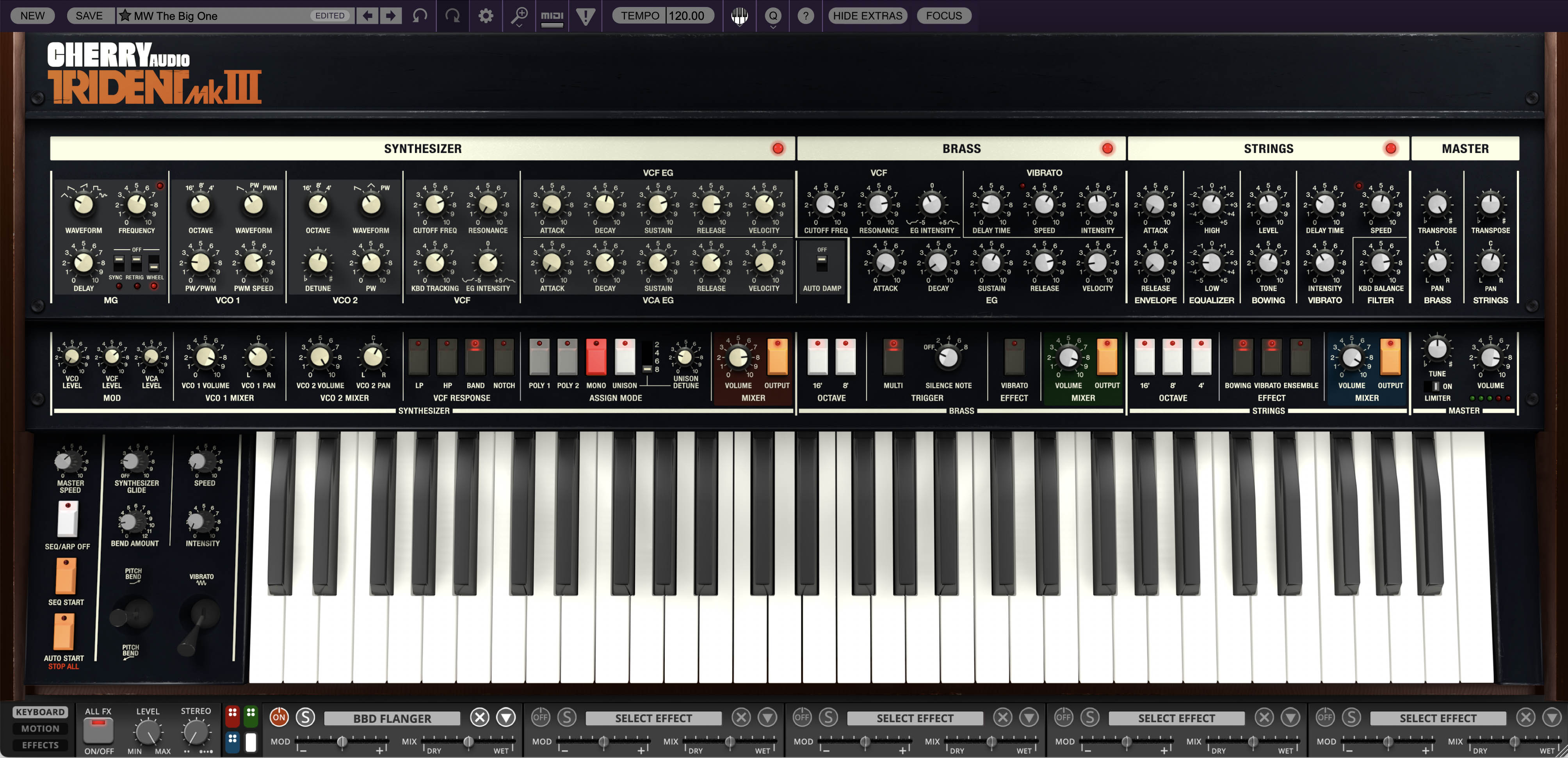Getting Started
The Trident Mk III is more than just a synthesizer. It’s three instruments living under one roof, designed to play together like a keyboard-based supergroup. At its heart, you’ll find a lush polysynth, a punchy brass machine, and a silky string section, each with its own dedicated controls.
Each of Trident’s three sections provides 16-voice polyphony. In practical terms, you can trigger 16 discrete synth voices, 16 brass voices, and 16 string voices simultaneously without note stealing. The Synthesizer section is implemented as true polyphony, with a complete signal path (including a dedicated filter) allocated per voice. The Brass and Strings, however, retain the paraphonic structure of the original hardware: multiple oscillators feed into a single shared filter and envelope stage, creating the cohesive, ensemble-like response that defines their character.
This hybrid voice architecture is central to Trident’s sonic identity. The polysynth delivers per-note precision and articulation, while the paraphonic Brass and Strings generate unified textures that swell and breathe as one. Layered together, the interaction produces a composite sound that feels broader and more dimensional than conventional polyphony alone.
On their own, each section of the Trident is powerful. Together, they’re unstoppable and form a layered, living wall of sound that can range from delicate string beds to brassy blasts to polyphonic fireworks. That’s why the Trident has always been described as “majestic.” It’s an entire orchestra living inside a synthesizer.
Below is a quick bird’s-eye view of what each section brings to the party.
Synthesizer Section
At the core of Trident lies its poly synth, its most powerful and flexible voice. It's a sound design workshop for everything from searing leads to subtle soundscapes. With two beefy oscillators per voice (sawtooth, pulse, and pulse-width modulation are on the menu), it’s capable of everything from cathedral-sized pads to sharp, biting leads. The filters are fully featured with cutoff, resonance, keyboard tracking, envelope amount so you can sculpt from smooth and mellow to screaming resonance. Add in envelope generators, a versatile LFO, and unison detune, and you’ve got all the raw, juicy analog tone you could ask for. In short, this is the “take-me-seriously” section. It's the part that reminds you why big, analog-style polyphony can still make other synths seem thin by comparison.
Brass Section
The brass section is where the Trident adds more muscle. Designed to emulate horns, but equally at home delivering bold synth stabs, it comes with its own filter, envelopes, vibrato controls, and octave switches. Want massive layered fanfares? Done. Need biting, syncopated accents to punch through a mix? Easy. You can even dial in unique behaviors with the trigger modes, including Silence Note mode, which only wakes up the brass when you play a chord thick enough to need it. Think of it as your built-in horn section. It's sometimes brassy, sometimes brash, and always attention-grabbing.
Strings Section
Ah, synth strings. Smooth, silky, and dripping with ensemble chorus. The Trident’s string machine is all about lush pads and orchestral sweeps. You get octave layering (bass, mid, and high), plus simple but musical attack and release controls. There’s also a built-in EQ to tilt the sound toward bright synth violins or darker synth cellos, and effects like vibrato, ensemble, and bowing to add character or exaggerated richness. Close your eyes and you’re halfway to Blade Runner.
Master Section
Finally, the Master controls tie everything together. Here you can balance brass and string levels, tweak their transposition and panning, set global tuning, and rein in the whole beast with a handy limiter. It’s where you blend all three sound engines into a single, performance-ready instrument.
Mix, Match, or Go Solo
One of the Trident’s secret strengths is flexibility. Sure, you can fire up all three sections at once and unleash a full orchestra that could shake rafters. But you don’t have to.
Single Section Mode: Sometimes less is more. Need a classic analog pad? The polysynth alone will get you there. Want that unmistakable string-machine shimmer? Switch off everything else and let it shine.
Two’s Company: Brass plus strings gives you instant symphonic rock vibes. Synth plus brass makes a killer combo for punchy leads. And synth plus strings? Think sweeping cinematic layers that fill your musical space in the best way possible.
Full House: If you want maximum drama bring all three to the stage. Just remember: balance is everything, and the Master section makes it easy.
So keep in mind that Trident doesn’t force you into all or nothing. It adapts to your arrangement and your imagination whether you’re sculpting delicate textures or unleashing a massive wash of sound.
